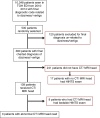Usage of the HINTS exam and neuroimaging in the assessment of peripheral vertigo in the emergency department
- PMID: 30201056
- PMCID: PMC6131950
- DOI: 10.1186/s40463-018-0305-8
Usage of the HINTS exam and neuroimaging in the assessment of peripheral vertigo in the emergency department
Abstract
Background: Dizziness is a common presenting symptom in the emergency department (ED). The HINTS exam, a battery of bedside clinical tests, has been shown to have greater sensitivity than neuroimaging in ruling out stroke in patients presenting with acute vertigo. The present study sought to assess practice patterns in the assessment of patients in the ED with peripherally-originating vertigo with respect to utilization of HINTS and neuroimaging.
Methods: A retrospective cohort study was performed using data pertaining to 500 randomly selected ED visits at a tertiary care centre with a final diagnostic code related to peripherally-originating vertigo between January 1, 2010 - December 31, 2014.
Results: A total of 380 patients met inclusion criteria. Of patients presenting to the ED with dizziness and vertigo and a final diagnosis of non-central vertigo, 139 (36.6%) received neuroimaging in the form of CT, CT angiography, or MRI. Of patients who did not undergo neuroimaging, 17 (7.1%) had a bedside HINTS exam performed. Almost half (44%) of documented HINTS interpretations consisted of the ambiguous usage of "HINTS negative" as opposed to the terminology suggested in the literature ("HINTS central" or "HINTS peripheral").
Conclusions: In this single-centre retrospective review, we have demonstrated that the HINTS exam is under-utilized in the ED as compared to neuroimaging in the assessment of patients with peripheral vertigo. This finding suggests that there is room for improvement in ED physicians' application and interpretation of the HINTS exam.
Keywords: Dizziness; HINTS; Head impulse; Neuroimaging; Vertigo.
Conflict of interest statement
Ethics approval and consent to participate
Our study was approved by our local REB.
Consent for publication
Not applicable.
Competing interests
The authors declares that they have no competing interests.
Publisher’s Note
Springer Nature remains neutral with regard to jurisdictional claims in published maps and institutional affiliations.
Figures



References
-
- Schneiderman N, Bies C, Chan SB, Garcia C. Vertigo, ataxia, and strokes: an emergency department study. Ann Emerg Med. 2015;66(4):S84. doi: 10.1016/j.annemergmed.2015.07.263. - DOI
MeSH terms
LinkOut - more resources
Full Text Sources
Other Literature Sources
Medical
Miscellaneous

